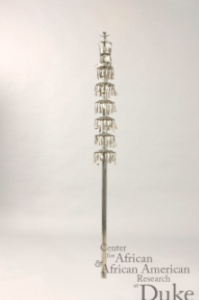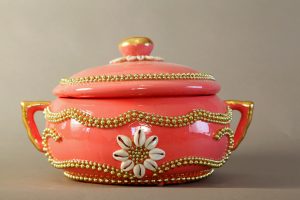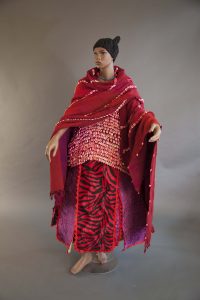Eli Van Buren
The symbolism of the head has a very powerful meaning in Yoruba and the African Diaspora religions’ culture. It is said that one has two heads: the outer spiritual head and the inner spiritual head. I don’t really care about the outer head. The inner spiritual head is physically represented in the Ile Ori, or the “House of the Head.” I chose to study the Ile Ori in the Spirited Things exhibition because I’d like to realize why ancient Yoruba peoples put such a strong emphasis on the head and how those practices translated to Haitian Vodun across generations and the Atlantic ocean. The inner head is so central to Afro-Atlantic spirituality that people would almost entirely cover their Ile Ori with cowrie shells, the equivalent to plastering the steering wheel of your car with dollar bills. In Black Atlantic spirituality, the head is closely tied to the concept of Ifa; fate or destiny. In understanding the significance of something so culturally important, one can see into the values of a culture to gain a view of a much broader concept: how this specific culture approaches one of humanity’s greatest spiritual questions about fate, destiny, and free will.
A couple class readings evidence and answers can be pulled from include The Yoruba World by Drewal, Pemberton, and Abiodun, as well as Afro-Caribbean Spirituality: A Haitian Case Study by Karen McCarthy Brown. The former article touches on the importance of the inu ori (inner head), ile ori, and the individuality associated with both. “The privacy and uniqueness of a person is the theme of the ile ori (‘house of the head’)…the object holds a symbol…of a person’s inner, spiritual essence.” (Drewal Pemberton Abiodun 27) In contrast to expressing a person’s individuality, the inu ori has much to do with spirit possession; orisa inhabiting one’s head and body. The Haitian case study can lend some insight into showing what methods and symbols have changed from traditional Yoruba worship to Vodun in the context of possession. Both of these two articles provide a wealth of information as a base for my continued external research to expand upon.
To find some answers, or at least the information I need to form my own answers, I should consult our UVM library to find some published sources on the Ile Ori. Ideally some sort of in depth analysis of the sculpture, explaining the different parts and meanings of each, though I may need to look through a few sources to find consistencies. Additionally, I am sure Duke University’s African religions website has quite a few articles on what I’m looking for. Context-providing secondary sources could be anything from traditional stories pertaining to the importance of the Ile Ori, to anthropological articles detailing how people relate to their Ile Ori and treat it in an everyday context.
https://docs.google.com/document/d/1Wn4-n9Ij01RA9pvItlslwNflXLrl7opU4wnmL0PVLr8/edit?usp=sharing

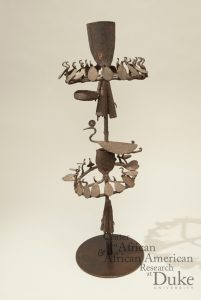

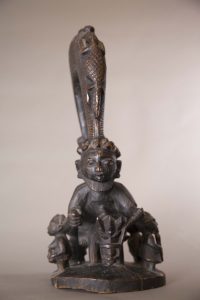
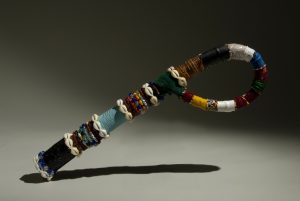 The ibiri, is a scepter-like object carried by the orixa of dance, death, disease and mud; Nanã. Nanã is an orixa of the Brazilian practice of Candomble. The ibiri was said to have been for with Nanã, in the placenta, and the staff itself grew as Nanã aged. However, the staff was placed into the earth, and Nanã was temporarily seperated from it. Until, her son Omolú had found it and brought it back to his mother, and this is what the word ibiri is translated into “Son-found-it- and brought-back-to-me” as found on page 71 in our textbook. The ibiri, is a twin scepter, to the xaxará, the scepter had by Omolú, god of pestilence, and her son. The ibiri is made of a gathered bunch of the ribs of palm fronds, around which is an intricately interwoven net of woven African straw, and adorned with various colored swatches, especially of the colors blue and white, and cowry shells. The colors of blue and white are especially associated with Nanã. The ibiri, is a symbol to the orixa, of when she carried her son in her arms as an infant.
The ibiri, is a scepter-like object carried by the orixa of dance, death, disease and mud; Nanã. Nanã is an orixa of the Brazilian practice of Candomble. The ibiri was said to have been for with Nanã, in the placenta, and the staff itself grew as Nanã aged. However, the staff was placed into the earth, and Nanã was temporarily seperated from it. Until, her son Omolú had found it and brought it back to his mother, and this is what the word ibiri is translated into “Son-found-it- and brought-back-to-me” as found on page 71 in our textbook. The ibiri, is a twin scepter, to the xaxará, the scepter had by Omolú, god of pestilence, and her son. The ibiri is made of a gathered bunch of the ribs of palm fronds, around which is an intricately interwoven net of woven African straw, and adorned with various colored swatches, especially of the colors blue and white, and cowry shells. The colors of blue and white are especially associated with Nanã. The ibiri, is a symbol to the orixa, of when she carried her son in her arms as an infant.